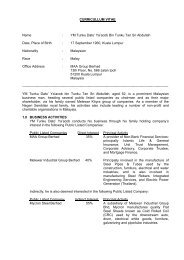Annual Report (Complete) - MYCRON Steel Berhad
Annual Report (Complete) - MYCRON Steel Berhad
Annual Report (Complete) - MYCRON Steel Berhad
Create successful ePaper yourself
Turn your PDF publications into a flip-book with our unique Google optimized e-Paper software.
Notes to the Financial Statements<br />
30 June 2010<br />
(continued)<br />
2. SUMMARY OF SIGNIFICANT ACCOUNTING POLICIES (continued)<br />
(a)<br />
Basis of preparation (continued)<br />
(iv)<br />
Standards, amendments to published standards, interpretations to existing standards that are not applicable and<br />
are not effective to the Group (continued)<br />
• The amendment to FRS 2 “Share-based Payment: Vesting Condition and Cancellations”<br />
• The amendment to FRS 5 “Non-current Assets Held for Sale and Discontinued Operations”<br />
• The amendment to FRS 117 “Leases”<br />
• The amendment to FRS 120 “Accounting for Government Grants”<br />
• The amendment to FRS 129 “Financial <strong>Report</strong>ing in Hyperinflationary Economies”<br />
• The amendment to FRS 140 “Investment Property”<br />
• IC Interpretation 13 “Customer Loyalty Programme”<br />
• IC Interpretation 14 “FRS 119 The Limit on a Defined Benefit Assets, Minimum Funding Requirements and Their<br />
Interaction”<br />
The amendments to published standards and interpretations to existing standards that are effective for periods<br />
beginning on or after 1 July 2010 are as follows:<br />
• The amendment to FRS 5 “Non-current Assets Held for Sale and Discontinued Operations”<br />
• The revised FRS 3 “Business Combinations”<br />
• IC Interpretation 12 “Service Concession Arrangements”<br />
• IC Interpretation 15 “Agreements for Construction of Real Estates”<br />
• IC Interpretation 16 “Hedges of a Net Investment in a Foreign Operation”<br />
• IC Interpretation 17 “Distribution of Non-cashAssets to Owners”<br />
(b)<br />
Basis of consolidation<br />
(i)<br />
Subsidiaries<br />
Subsidiaries are those corporations, partnerships or other entities (including special purpose entities) in which the<br />
Group has power to exercise control over the financial and operating policies so as to obtain benefits from their<br />
activities, generally accompanying a shareholding of more than one half of the voting rights. The existence and<br />
effect of potential voting rights that are currently exercisable or convertible are considered when assessing whether<br />
the Group controls another entity.<br />
Subsidiaries are consolidated using the purchase method of accounting.<br />
Under the purchase method of accounting, subsidiaries are fully consolidated from the date on which control is<br />
transferred to the Group and are de-consolidated from the date that control ceases. The cost of an acquisition is<br />
measured as fair value of the assets given, equity instruments issued and liabilities incurred or assumed at the date of<br />
exchange, plus costs directly attributable to the acquisition.<br />
Identifiable assets acquired and liabilities and contingent liabilities assumed in a business combination are measured<br />
initially at their fair values at the acquisition date, irrespective of the extent of any minority interests. The excess of<br />
the cost of acquisition over the fair value of the Group’s share of the identifiable net assets acquired at the date of<br />
acquisition is reflected as goodwill. See the accounting policy Note 2 (c) on goodwill. If the cost acquisition is less<br />
than the fair value of the net assets of the subsidiary acquired, the difference is recognised directly in the income<br />
statement.<br />
Where more than one exchange transaction is involved, any adjustment to the fair values of the subsidiary’s<br />
identifiable assets, liabilities and contingent liabilities relating to previously held interests of the Group is accounted<br />
for as a revaluation.<br />
Intra-group transactions, balances and unrealised gains on transactions between Group companies are eliminated.<br />
Unrealised losses are also eliminated but considered an impairment indicator of the asset transferred. Accounting<br />
policies of subsidiaries have been changed where necessary to ensure consistency with the policies adopted by the<br />
Group.<br />
The gain or loss on disposal of a subsidiary is the difference between net disposal proceeds and the Group’s share of<br />
its net assets as of the date of disposal, including the cumulative amount of any exchange differences that relate to<br />
the subsidiary, and is recognised in the consolidated income statement.<br />
pg 55 | Mycron <strong>Steel</strong> <strong>Berhad</strong>











